1. Yaman
Yaman - This rag is known by Kalyan or Yaman.
In this rag all swaras are suddh except Ma. Sa and Pa are weak in the Aroha as instance - ni re
ga (tivra) ma, dha ni. If in this raga using both Ma (tivra)and ma (suddh,) then it called
Yaman Kalyan and its totally different raga .it's interesting that, In yaman kalyan suddh Ma
is used very limited only in Avaroh between two gandhar like - pa, (tivra) Ma, ga, ma ga re,
ni, re sa.
That - Kalyan,
Jati - Sampurna - Sampurna,
Varjit swar - suddh Ma,
Aaroha - sa re ga, (tivra) ma pa, dha ni sa,
Avaroha - sa ni dha pa, (tivra) ma ga re sa,
Pakad - ni re ga re ni re sa, pa re ga re ni re sa,
Vadi - Samvadi - Ga and Ni,
Komal or Tivra Swar - Tivra Ma,
Time of singing - First part of the night,
Nature of Rag - peaceful,
Rag Vishtar - All Saptak ,
Sam prkirti rag - yaman kalyan.
2. Bhupali
Bhupali - In this rag thumari is abandoned albeit it's a semi classical rag.
Same raga called Mohan in carnatic music.
That - Kalyan,
Jati - Audav - Audav,
Varjit swar - Ma and Nishad,
Aaroha - sa re ga, pa, dha sa,
Avaroha - sa dha pa, ga re sa
Pakad - ga re sa, dha sa re ga, pa gad ha pa ga, re sa,
Vadi - Samvadi - Ga and dha,
Komal or Tivra Swar - NA,
Time of singing - First part of the night,
Nature of Rag - devotional,
Rag Vishtar - Mandra and Madhya ,
Samprakirti rag - rag Deshakar, Jait Kalyan, and Audav Devgiri.
3. Kafi
Kafi - It's a historical and old raga and various folk musics
(Tappa, Hori, Dadra, Kirtan, devotional songs) can easily find in all parts of India.
That - Kafi,
Jati - Sampurna - Sampurna,
Varjit swar - Suddh Madhyam and suddh Nishad ,
Aaroha - sa re ga komal ma pa, dha Ni komal Sa,
Avaroha - sa komal Ni dha pa ma, ga komal re sa,
Pakad - re pa ma pa komal ga re, ma ma pa,
Vadi - Samvadi - Pa and Sa,
Komal or Tivra Swar - gandhar and nishad,
Time of singing - second part of the night,
Nature of Rag - Playful (shringar),
Rag Vishtar - Mandra and Madhya ,
Samprakirti rag - Mishra Kafi.
4. Bhairav
Bhairav - It's a very old and historical rag, bhairav has its name from Bhairava an incarnation of shiva. In carnatic
music they start to learn from this raga and it's called there as "Mayamalavgaud"raga. In the India (shikh tradition)
Guru Granth Sahib, the Sikh holy Granth (book) there are a total of 31 raga compositions and this raga appearing as
twenty-fourth number of raga in the series. The composition of this raga appears on a total of 43 pages from page numbers
1125 to 1168. This raga was used by Guru Nanak, Guru Amar Das, Guru Ram Das, and Guru Arjan Saheb for 99 hymns. It's also
called a Sandhi-Prakash rag.
That - Bhairav,
Jati - Sampurna - Sampurna,
Varjit swar - suddh Re and Dha,
Aaroha - sa komal re ga ma pa, komal dha Ni Sa,
Avaroha - Sa Ni dha komal pa ma, ga re komal Sa,
Pakad - ga ma komal dha komal dha pa, ma pa ga ma komal re komal re sa ,
Vadi - Samvadi - dhaivat and Rishabh,
Komal or Tivra Swar - Rishbh and Dhaivat,
Time of singing - Early Morning (4 to 7),
Nature of Rag - Pathos and deep,
Rag Vishtar - Mandra and Madhya ,
Samprakirti rag - Ahir Bhairav, Bairagi, Gunkali, Hijaz Bhairav, Nat Bhairav, Ramkali, Jogiya and Kalingda.
5. Bihag
Bihag - It's created by Bilawal that. In Aaroh re and dha is abandoned,
Jati Audav - sampuran, vadi - gandhar and samvadi - Nishad, time of singing - first part of the night. Sometimes in Avroh Tivra ma is
used in this raga.
That - Bilawal,
Jati - Audav - Sampurna,
Varjit swar - Re and Dha,
Aaroha - Ni sa ga, ma pa, Ni Sa,
Avaroha - sa Ni, dha pa, Tivra ma pa ga ma ga, re sa,
Pakad - ni sa ga ma pa, Tirva ma pa ga ma ga, re sa,
Vadi - Samvadi - Pa and Sa,
Komal or Tivra Swar - gandhar and nishad,
Time of singing - first part of the night,
Nature of Rag - Playful (shringar),
Rag Vishtar - Mandra and Madhya,
Samprakirti rag - Maru Bihag, Bihagra.
6. Alhaiya Bilawal
Alhaiya Bilawal - This rag is a part of the Bilawal rag. Jati - Shadav -
Sampuran, Madhyam abandoned in Aaroh and in Avaroh komal Ni is used in this rag. It's very popular raga in north India. Samprakirti rag -
Bilawal, Shuddha Bilawal, Devgiri Bilawal, Shukla Bilawal, Kakubh Bilawal, time of singing - Morning, around 9AM-12NOON.
That - Bilawal
Jati - Shadav - Sampurna
Varjit swar - Madhyam in Aaroh and Suddh Nishad in Avaroh
Aaroha - sa, ga re ga pa, dha, Ni Sa
Avaroha - sa Ni, dha pa, dha ni dha pa, ma ga ma re, sa
Pakad - ga re s ga pa, ma ga ma re, ga pa dha ni dha pa
Vadi - Samvadi - dha and ga
Komal or Tivra Swar - avaroh Ni komal
Abandoned swar - Ma in aaroh
Time of singing - first part of the day
Nature of Rag - NA
Rag Vishtar - Mandra, Madhya and Tar
Samprakirti rag - Bilawal, Shuddha Bilawal, Devgiri Bilawal, Shukla Bilawal, Kakubh Bilawal
7. Khamaj
Khamaj - This raga is more appropriate to the semi-classical and lighter
styles. In the Carnatic music equivalent of the Khamaj Thaat is Harikambhoji, the 28th Melakarta raga.
That - khamaj,
Jati - Shadav - Sampurna ,
Varjit swar - Rishabh in Aaroh and Suddh Ni in Avaroh,
Aaroha - sa ga, ma pa, dha Ni Sa,
Avaroha - sa komal Ni dha pa, ma ga, re sa,
Pakad - ga re s ga pa, ma ga ma re, ga pa dha ni dha pa,
Vadi - Samvadi - Gandhar and Nishad,
Komal or Tivra Swar - avaroh Ni komal,
Time of singing - second part of the night,
Nature of Rag - Playful (shringar),
Rag Vishtar - Mandra, Madhya and Tar,
Samprakirti rag - Bilawal, Shuddha Bilawal, Devgiri Bilawal, Shukla Bilawal, Kakubh Bilawal.
8. Bage shri
Bage shri - That kafi, Jati - Audav - Sampurna, Varjit swar - Rishabh and pancham in Aaroh, Vadi - Samvadi - Madhyam and Nishad,
Time of singing - second part of the night, Nature of Rag - Playful (shringar), Samprakirti rag - Bhimpalasi.
That - kafi,
Jati - Audav - Sampurna ,
Varjit swar - Rishabh and pancham in Aaroh ,
Aaroha - komal Ni sa komal ga, ma dha komalNi Sa,
Avaroha - sa komal Ni dha, ma pa dha ga s ma komal ga re sa,
Pakad - dha ni sa ma, dha komal ni dha ma, ma pa dha ga, ma ga re sa,
Vadi - Samvadi - Madhyam and Nishad,
Komal or Tivra Swar - avaroh komal ga and Ni,
Time of singing - second part of the night,
Nature of Rag - Playful (shringar),
Rag Vishtar - Mandra, Madhya and Tar,
Samprakirti rag - Bhimpalasi.
9. Durga
Durga - The name Durga is derived from the name of the goddess Amba or
Parvati. She is the wife of Shiva, and is associated with great power. She is also referred to as "Ma Durga" or "Durga Mata",
which means "Mother Durga". She is said to represent patience and fearlessness. Same raga is in south called suddh Saveri.
There are two ragas as Durga 1. Bilawal that 2. Khamaj that, 1st is more popular in society.
That - Bilawal,
Jati - Audav - Audav,
Varjit swar - Gandhar and Nishad in Aaroh and Avaroh both,
Vadi - Samvadi - Dhaivat and Rishabh ,
Time of singing - second part of the night,
Nature of Rag - Playful (shringar), Samprakirti rag - Jaldhar kedar.
10. Aashawari
Aashawari
That - Aashawari,
Jati - Audav - Sampurna,
Varjit swar - Gandhar and Nishad in Aaroh,
Vadi - Samvadi - Dhaivat and Gandhar ,
Time of singing - second part of the day,
Nature of Rag - sad and deep,
Samprakirti rag - Jaunpuri and Darwari kanhda.
11. Bhairavi
Bhairavi
That - Bhairavi,
Jati - Sampurna - Sampurna,
Varjit swar - Suddh re , ga, dha and ni, Rishabh, Gandhar, Dhaiwat & Nishad in Aaroh and Avaroh both,
Vadi - Samvadi - Madhyam and Shadaj ,
Time of singing - Morning time,
Nature of Rag - (playful) shringar,
Samprakirti rag - Bilaskhani Todi
12. Birndawani Sarang
Birndawani - In this raga Thumari is avoidable. This raga is created
in Uttar Pradesh based on folk song.
That - kafi,
Jati - Audav - Audav,
Varjit swar - Gandhar, Dhaiwat,
Vadi - Samvadi - Rishabh and Pancham ,
Time of singing - Afternoon,
Nature of Rag - (playful) shringar,
Samprakirti rag - Sur Malhar, Suddh Sarang, Mian ki Sarang, Madhyamadi sarang.
13. Bhimpalasi
Bhimpalasi - In this raga Thumari is avoidable.
That - kafi,
Jati - Audav - Sampurna,
Varjit swar - Rishabh and Dhaiwat in Aaroh,
Vadi - Samvadi - Madhyam and Sadaj ,
komal & Tivra - Gandhar and Nishad,
Time of singing - Afternoon (third part of the day),
Nature of Rag - deep,
Samprakirti rag - Bageshwari.
14. Desh
Desh
That - khamaj,
Jati - Audav - Sampurna,
Varjit swar - Ganadhar and Dhaiwat in Aaroh,
Vadi - Samvadi - Rishabh and Pancham ,
komal & Tivra - komal Ni in Avaroh,
Time of singing - second part of the night,
Nature of Rag - playful (Shringar),
Samprakirti rag - Sorath, Khamaj and Tilak Kamod. Mostly in this raga Thumari and Drut Khyala is in practice. Using both Ni in Aaroh simple Ni and in Avaroh komal Ni.
15. Tilak Kamod
Tilak Kamod
That - khamaj,
Jati - Audav - Shadav,
Varjit swar - Ganadhar and Dhaiwat in Aaroh and Rishabh in Aavroh,
Vadi - Samvadi - Shadaj and Pancham ,
komal & Tivra - NA,
Time of singing - second part of the night,
Nature of Rag - playful (Shringar),
Samprakirti rag - Sorath and Desh. Mostly in this raga Thumari and Drut Khyala is in practice.
16. Hamir
Hamir
That - kalyan,
Jati - Sampurna,
Varjit swar - NA,
Vadi - Samvadi - Dhaiwat and Gandhar,
komal & Tivra - komal Ma in Aaroh and Aavorh (both) Ma is used in practice,
Time of singing - First part of the night,
Nature of Rag - deep,
Samprakirti rag - Kamod and Kedar. In practice, Pancham is used very minimum.
17. Kedar
Kedar
That - kalyan,
Jati - Audav - Shadav,
Varjit swar - In Aaroh Rishabh and Gandhar and Aavroh Gandhar,
Vadi - Samvadi - Madhyam and Shadaj,
komal & Tivra - komal and suddh Ma in Aaroh and Aavorh (both) Ma is used in practice,
Time of singing - First part of the night,
Nature of Rag - deep,
Samprakirti rag - Hamir & Kamod.
Notation of Nyas - sa, ma & pa
18. Tilang
Tilang
That - Khamaj,
Jati - Audav - Audav,
Varjit swar - Rishabh and Dhaivat,
Vadi - Samvadi - Gandhar and Nishad,
komal & Tivra - Komal and suddh (both) Ni in Aaroh and Aavorh
Time of singing - Second part of the night,
Nature of Rag - playful (shringar),
Samprakirti rag - NA, Notation of Nyas - sa, Ga & pa
19. Kalingda
Kalingda
That - Bhairav,
Jati - Sampurna - Sampurna,
Varjit swar - Suddh Rishabh and Dhaivat,
Vadi - Samvadi - Pancham and Shadaj,
komal & Tivra - Komal Rishabh and Dhaiwat,
Time of singing - Early morning (4 to 7),
Nature of Rag - playful (shringar),
Samprakirti rag - Bhairav,
Notation of Nyas - sa, Ga & pa
20. Patdeep
Patdeep
That - Kafi,
Jati - Audav - Sampurna,
Varjit swar - in Aaroh Rishabh and Dhaivat,
Vadi - Samvadi - Pancham and Shadaj,
komal & Tivra - Komal Gandhar,
Time of singing - Third part of the day,
Nature of Rag - playful (shringar),
Samprakirti rag - Bhimpalasi,
Notation of Nyas - sa, pa & ni
21. Jaunpuri
Jaunpuri
That - Ashawari,
Jati - Shadav - Sampurna,
Varjit swar - Gandhar in Aaroh,
Vadi - Samvadi - Dhaiwat and Gandhar,
komal & Tivra - komal Gandhar, Dhaiwat & Nishad ,
Time of singing - second part of the day,
Nature of Rag - NA,
Samprakirti rag - Ashawari,
Notation of Nyas - sa & pa
22. Malkauns
Malkauns In the South India it is known as Hindolam raga
That - Bhairavi,
Jati - Audav - Audav,
Varjit swar - Rishabh & Panchah in Aaroh and Avaroh both,
Vadi - Samvadi - Madhyam and Shadaj,
komal & Tivra - komal Gandhar, Dhaiwat & Nishad in Aaroh & Avaroh both,
Time of singing - Third part of the night,
Nature of Rag - peaceful & deep,
Samprakirti rag - Chandrakaunsh,
Notation of Nyas - sa ga & ma.
23. Pilu
Pilu
That - kafi,
Jati - Audav - Sampurna,
Varjit swar - Rishabh & Dhaiwat in Aaroh,
Vadi - Samvadi - Gandhar and Nishad,
komal & Tivra - komal Gandhar, Dhaiwat & Nishad in Avaroh,
Time of singing - Third part of the day, Nature of Rag - playful (Shringar),
Samprakirti rag - NA,
Notation of Nyas - Re, komal ga & pa.
Note : In singing both komal and suddh Rishabh, Gandhar, Dhaiwat and Nishad is used by artists.
This raga doesn't have specific feature and it's very narrow in nature.
24. Deshkar
Deshkar To make the difference from Bhupali Raga mostly Rishabh is abandoned in practice.
That - Bilawal,
Jati - Audav - Audav,
Varjit swar - Madhyam & Nishad,
Vadi - Samvadi - Dhaiwat and Gandhar,
komal & Tivra -NA,
Time of singing - Second part of the day,
Nature of Rag - deep,
Samprakirti rag - Bhupali,
Notation of Nyas - pa, Dha & Tar sa.
25. Shankra
Shankra
That - Bilawal,
Jati - Audav - shadav,
Varjit swar - in Aaroh Rishabh & Madhyam and in Aavroh only Madhyam,
Vadi - Samvadi - Pancham and Shadaj,
komal & Tivra -NA,
Time of singing - third part of the night,
Nature of Rag - deep,
Samprakirti rag - Malshree,
Notation of Nyas - sa, ga, pa and ni.
26. Jayjaywanti
Jayjaywanti
That - khamaj,
Jati - Sampurna - Sampurna,
Varjit swar - NA,
Vadi - Samvadi - Rishabh -Pancham,
komal & Tivra -both komal and suddh Gandhar & Nishad,
Time of singing - second part of the night,
Nature of Ragv - deep,
Samprakirti rag - Desh,
Notation of Nyas - Sa, Re & Pa.
Note : because of using both Gandhar and Nishad, it's called Parmel - praveshak raga.
27. Kamod
Kamod
That - Kalyan,
Jati - Vakra - Sampurna,
Varjit swar - NA,
Vadi - Samvadi -Pancham - Rishabh,
komal & Tivra - Tivra Ma,
Time of singing - First part of the night,
Nature of Rag - deep,
Samprakirti rag - Kedar and Hamir,
Notation of Nyas - Sa, Re & Pa.
Note : with Tivra Ma, Suddh Ma is also applicable in this raga.
28. Marwa
Marwa
That - Marwa,
Jati - Shadav - shadav,
Varjit swar - Pancham and suddh Madhyam ,
Vadi - Samvadi - komal Rishabh and Dhaiwat,
komal & Tivra - komal Rishabh and Tivra Ma,
Time of singing - Last part of the day,
Nature of Rag - dry and playful,
Samprakirti rag - Puria,
Notation of Nyas - komal Re & dha. It's also called evening sandhi - prakash rag.
29. Multani
Multani
That - Todi,
Jati - Audav - Sampurna,
Varjit swar - in Aaroh Rishabh and Dhaiwat,
Vadi - Samvadi - Pancham & Shadaj,
komal & Tivra - komal Rishabh, komal Gandhar, komal Dhaiwat and Tivra Madhyam,
Time of singing - Fourth part of the day,
Nature of Rag - deep,
Samprakirti rag - Todi,
Notation of Nyas - Sa, Ga, Pa & Ni. It's also called Parmel - Praveshak raga.
Note : if inspite of using komal rishabh and dhaiwat using suddh rishabh and dhaiwat than it will be Madhuwanti raga.
30. Sohani
Sohani
That - Marwa,
Jati - Audav - Shadav,
Varjit swar - in Aaroha Rishabh and in Avaroha Dhaiwat,
Vadi - Samvadi - Dhaiwat & Gandhar,
komal & Tivra - komal Rishabh and Tivra Madhyam,
Time of singing - Fourth part of the night,
Nature of Rag - playful,
Samprakirti rag - Puria and Hindol,
Notation of Nyas - Ga, Dha and Tar Sa.
Note : both komal and suddh Ni is used in this raga. In history, there is not any details about it,
according to Pt. Bhatkhande in (karmic pushtak part 4) is defined that it's the mixture of three ragas
Bageshwari, Adana and Mian Malahar.
31. Bahar
Bahar
That - Kafi,
Jati - Shadav - Shadav,
Varjit swar - in Aaroh Rishabh and in Avaroh Dha,
Vadi - Samvadi - Madhyam and shadaj,
komal & Tivra - komal Gandhar and Nishad,
Time of singing - Third part of the night,
Nature of Rag - playful,
Samprakirti rag - Mian Malhar,
Notation of Nyas - Sa Ma & Pa. It's also called Maushmi raga.
32. Purvi
Purvi
That - Purvi,
Jati - Shampurna,
Varjit swar - suddh Rishabh and Gandhar,
Vadi - Samvadi - Gandhar & Nishad,
komal & Tivra - komal Rishabh, Gandhar and Tivra and suddh both Madhyam,
Time of singing - Evening,
Nature of Rag - Deep,
Samprakirti rag - in Purvang Paraj and in Utrang Puriadhanashree ,
Notation of Nyas - Sa, Ga & Pa. Its also called evening sandhi prakash raga.
33. Puria
Puria
That - Marwa,
Jati - Shadav,
Varjit swar - pancham,
Vadi - Samvadi - Gandhar & Nishad,
komal & Tivra - komal Rishabh and Tivra Madhyam,
Time of singing - Evening,
Nature of Rag - Deep,
Samprakirti rag - Marwa and Sohni,
Notation of Nyas - Sa, Ga & Ni.
Note : It's also called a sandhi Parkash and Parmel parveshak raga.
34. Gaud Malahar
Gaud Malahar
That - Khamaj,
Jati - Shampurna,
Varjit swar - NA,
Vadi - Samvadi - Madhyam & Shadaj,
komal & Tivra - in Avaroha komal Nishad with dhaiwat in curve otherwise suddh Nishad in Aaroha and Avaroha both,
Time of singing - second part of the night,
Nature of Rag - Playful,
Samprakirti rag - NA,
Notation of Nyas - Sa, Ni & Ma.
Note : It's also called a seasonal (Mausmi) raga.
35. ChhayaNat
ChhayaNat
That - Kalyan,
Jati - Shampurna,
Varjit swar - NA,
Vadi - Samvadi - Rishabh and Pancham,
komal & Tivra - Tivra Madhyam,
Time of singing - First part of the night,
Nature of Rag - Playful,
Samprakirti rag - kamod and Hamir,
Notation of Nyas - Ga, Ma and pa.
Note : both komal and suddh Madhyam is used in this raga. It's a combination of two ragas Chhaya and Nat.
36. Shree
Shree
That - Purvi,
Aaroha - Sa, komal Re Re Ma Tivra Pa, Ni, Tar Sa,
Avaroha - Sa, Ni Dha, Pa, Tivra Ma Ga komal Re S Re, Sa,
Pakad - Sa, (kan Ga) Re (kan Ga) Re Sa, komal Re Pa, Tivra Ma Ga (kan Ga) Re (kan Ga) Re Sa,
Jati - Audav - Shampurna,
Varjit swar - In Aaroh Gandhar and Dhaiwat,
Vadi - Samvadi - komal Rishabh and Pancham,
komal & Tivra - komal Rishabh, Dhaiwat and Madhyam Tivra ,
Time of singing - Fourth part of the day,
Nature of Rag - Deep,
Samprakirti rag - NA,
Notation of Nyas - Re and Pa.
Note : it's also called a Sandhi Parkash raga.
37. Hindol
Hindol
That - kalyan,
Aaroha - Sa, Ga, Tivra Ma Dha Ni Dha, Tar Sa,
Avaroha - Tar Sa, Ni Dha, Tivra Ma Ga, Sa,
Pakad - Tar Sa, (kan Ni) Dha (kan Ni) Tivra Ma Dha Tar Sa,
Jati - Audav,
Varjit swar - Rishabh and Pancham,
Vadi - Samvadi - Dhaiwat and Gandhar,
komal & Tivra - Madhyam Tivra ,
Time of singing - First part of the day,
Nature of Rag - Deep,
Samprakirti rag - Sohni,
Notation of Nyas - Ga, Dha and Sa.
Note : This raga is appropriate for Dhrupad singing.
38. Gaud Sarang
Gaud Sarang
That - kalyan,
Aaroha - Sa Ga Re Ma Ga, Pa Tivra Ma Dha Pa, Ni Dha, Tar Sa,
Avaroha - Tar Sa, Dha, Ni Pa, Dha Tivra Ma Pa, Ga, Re Ma Ga, Pa Re Sa,
Pakad - Sa, Ga, Re Ma Ga Pa Re Re Sa,
Jati - Vakra Sampurna,
Varjit swar - NA,
Vadi - Samvadi - Gandhar and Dhaiwat,
komal & Tivra - Madhyam Tivra ,
Time of singing - Third part of the day,
Nature of Rag - Deep, Samprakirti rag - NA,
Notation of Nyas - Pa, komal Dha and Sa.
Note : By name it's a combination of two ragas Gaud and Sarang but feature shows combination of Raga Gaud and Kalyan. Somewhere it's a complicated raga.
39. Vibhas
Vibhas
That - Bhairav,
Aaroha - komal Re Ga Pa Komal Dha, Tar Sa,
Avaroha - Tar Sa, komal Dha Pa, Ga Pa komal Dha Pa, Ga komal Re Sa,
Pakad - komal Dha komal Dha Pa, Ga, Pa Ga komal Re Sa,
Jati - Audav - Audav,
Varjit swar - Madhyam and Nishad,
Vadi - Samvadi - Dhaiwat and Rishabh,
komal & Tivra - komal Rishabh & Dhaiwat ,
Time of singing - First part of the day,
Nature of Rag - Peaceful and Deep,
Samprakirti rag - Reva (from purvi that) and in Purvang jait,
Notation of Nyas - Pa, dha and Sa.
Note : There is three kind of vibhas and all are different in nature from each other.
Vibhas which belong to Bhairav is more in practice. It's also called a Morning Sandhi - Prakash Raga.
40. Darwari Kanhada
Darwari Kanhada
That - Ashawari,
Aaroha - Sa Re Ma (kan) Ga Ga Ma Re Sa, Ma Pa Ni (kan) Dha Ni Sa,
Aavroha - Tar Sa, komal Dha Dha komal Ni Pa, Ma Pa Ma (kan) Ga Ma Re Sa,
Pakad - Sa Re Ma (kan) komal Ga Ga Ga Ga (Ma) Sa Re Re Sa komal Dha komal Ni Re Sa,
Jati - Vakra sampurna,
Varjit swar - NA,
Vadi - Samvadi - Rishabh and Pancham,
Komal & Tivra - komal Gandhar, Dhaiwat and Nishad,
Time of singing - Third part of the Night,
Nature of Rag - Peaceful and Deep,
Samprakirti rag - Aadana,
Notation of Nyas - Sa, Re and Pa. It's also called "Mardana Raga".
Note : This raga is not found in any old script except Bhav Bhatt and Bhav Bhatt was contemporary of
Emperor ShahJahan but in old script defined about "Karnat" Rag and that "Karnat" word with the time and
culture may be has changed as kanhada and Darwari is the word which belong to Muslim Emperor age and slowly
- slowly it called by people "Darwari Kanhada".
* Mostly this Raga is expanded into Mandra and Madhya so that it's called a "Mardana Raga".
41. Todi
Todi
That - Todi,
Aaroha - Sa komal Re komal Ga, Tivra Ma komal Dha Ni Tar Sa,
Avaroha - Tar Sa Ni komal Dha Pa, Tivra Ma komal Ga, komal Re komal Ga Komal Re Sa,
Pakad - komal Dha Pa Tivra Ma komal Ga komal Ga komal Re komal Ga komal Re Sa.
Jati - sampurna,
Varjit swar - NA,
Vadi - Samvadi - Dhaiwat and Gandhar,
komal & Tivra - komal Rishabh, Gandhar, Dhaiwat and Tivra Madhyam,
Time of singing - Second part of the day,
Nature of Rag - Peaceful and Deep,
Samprakirti rag - Gurjari Todi and Multani,
Notation of Nyas - Ga and Dha. This raga has created by Tansen, so it's also called Mian ki Todi.
42. Aadana
Aadana
That - Ashawari,
Aaroha - Sa Re Ma Pa, komal Dha Ni Tar Sa,
Avaroha - Tar Sa komal Dha komal Ni Pa, Ma Pa komal Ga Ma Re Sa,
Pakad - Ma Pa komal dha komal Ni Tar Sa, komal Dha komal Ni Pa, Ma Pa komal Ga Ma Re Sa,
Jati - Shadav - sampurna,
Varjit swar - in Aaroh Gandhar,
Vadi - Samvadi - Tar Sa and Pancham,
komal & Tivra - komal Gandhar, Dhaiwat, Nishad,
Time of singing - Third part of the night,
Nature of Rag - Playful,
Samprakirti rag - Darwari Kanhda and Nayaki Kanhda,
Notation of Nyas - Pa and Tar Sa.
43. Ramkali
Ramkali
That - Bhairav,
Aaroha - Sa Ga, Ma Pa, komal Dha Ni Tar Sa,
Avaroha - Tar Sa Ni komal Dha Pa, Tivra Ma Pa, komal Dha komal Ni komal Dha Pa, Ga Ma komal Re Sa,
Pakad - Pa, Tivra Ma Pa komal dha komal Ni komal Dha Pa, Ga Ma komal Re komal Re Sa,
Jati - Shadav - sampurna,
Varjit swar - in Aaroh Rishabh,
Vadi - Samvadi - pancham and Shadaj,
komal & Tivra - komal Rishabh, Dhaiwat Nishad (both Nishad) and Tivra and suddh (both Madhyam),
Time of singing - First part of the day,
Nature of Rag - playful,
Nature of Rag - Peaceful and Deep,
Samprakirti rag - Bhairav,
Notation of Nyas - Sa and Pa.
Note - It's also called a Morning Sandhi - Parkash Raga.
44. Mian Malahar
Mian Malahar
That - Kafi,
Aaroha - Sa Ma (kan) Re Re Pa Ma (kan) komal Ga Ga Ma Re Sa, Ma Re Pa, Dha Ni Ni Tar Sa,
Avaroha - Tar Sa komal Ni Pa, Ma Pa, komal Dha komal Ni komal Dha Pa, Ga Ma komal Re Sa
Pakad - Pa, Tivra Ma Pa komal dha komal Ni komal Dha Pa, Ga Ma komal Re komal Re Sa,
Jati - sampurna - Shadav,
Varjit swar - in Avaroh Dhaiwat,
Vadi - Samvadi - Shadaj and Pancham,
komal & Tivra - komal Gandhar and Nishad (both Nishad),
Time of singing - Third part of the night,
Nature of Rag - Playful,
Samprakirti rag - Bahar,
Notation of Nyas - Sa, Re, pa and Ni.
Note : In old script there is no information about this raga but it's said that this raga is created by Mia Tansen. In this raga mostly song is related to rainy season.
It's also called a seasonal raga.
45. Paraj
Paraj
That - Purvi,
Aaroha - Ni Sa Ga, Tivra Ma Pa komal Dha Pa, Tivra Ma komal Dha Ni Tar Sa,
Avaroha - Tar Sa Ni komal Dha Pa, Tivra Ma Pa komal Dha Pa, Ga Ma Ga, Tivra Ma Ga komal Re Sa,
Pakad - Tar Sa, Ni komal Dha Pa, Tivra Ma Pa komal Dha Pa, Ga Ma Ga,
Jati - Shadav - sampurna,
Varjit swar - in Avaroh Dhaiwat,
Vadi - Samvadi - Shadaj and Pancham,
komal & Tivra - komal Rishabh Dhaiwat and both Tivra and suddh Madhyam,
Time of singing - Fourth part of the night,
Nature of Rag - Playful,
Samprakirti rag - in Purvang kalingra and in Utrang Vasant,
Notation of Nyas - Ga, pa, Ni and sa.
* It's called a Pramel - Praveshak raga.
46. Basant
Basant
That - Purvi,
Aaroha - Sa Ga, Tivra Ma komal Dha komal Re Ni Tar Sa,
Avaroha - Tar Re Ni komal Dha Pa, Tivra Ma Ga Tivra Ma Ma Ga, Tivra Ma komal Dha Ga Tivra Ma Ga, komal Re Sa,
Pakad - Tivra Ma komal Dha komal (Tar) Re (Tar) Sa, Ni komal Dha Pa, Tivra Ma Ga Tivra Ma Ma Ga,
Jati - Audav - sampurna,
Varjit swar - in Avaroh Rishabh and Pancham,
Vadi - Samvadi - Tar Shadaj and Pancham,
komal & Tivra - komal Rishabh Dhaiwat and both Tivra and suddh Madhyam,
Time of singing - Fourth part of the night,
Nature of Rag - Playful,
Samprakirti rag - Paraj, Purvi and Puriadhanashree,
Notation of Nyas - Ga, pa and sa.
Note : In spring season it's a Evergreen Raga.
47. Rag shree
Rag shree
That - Purvi,
Aaroha - Sa komal Re komal Re, Tivra Ma Pa, Ni Tar Sa,
Avaroha - Tar Sa, Ni komal Dha Pa, Tivra Ma Ga komal Re komal Re komal Re Sa,
Pakad - Sa, (kan)Ga komal Re (kan) Ga komal Re Sa, komal Re Pa, Tivra Ma Ga (kan) Ga komal Re Re (kan) Ga komal Re Sa,
Jati - Audav - sampurna,
Varjit swar - in Avaroh Gandhar and Dhaiwat,
Vadi - Samvadi - Komal Rishabh and Pancham,
komal & Tivra - komal Rishabh Dhaiwat and Tivra Madhyam,
Time of singing - Fourth part of the day,
Nature of Rag - Deep and peaceful,
Samprakirti rag - NA,
Notation of Nyas - Re and Pa.
Note : it's a very old and important Ancient raga in all four sects of Rag Ragini theory.
48. Puria Dhanashree
Puria Dhanashree
That - Purvi,
Aaroha - (Mandra) Ni komal Re Ga Tivra Ma Pa, Tivra Ma komal Dha Ni (Tar) Sa,
Avaroha - (Tar) Re, Ni komal Dha Pa, Tivra Ma Ga, Tivra Ma komal Re Ga komal Re Sa,
Pakad - (Mandra) Ni komal Re Ga Tivra Ma Pa, komal Dha Pa, Tivra Ma Ga Tivra Ma komal Re Ga, komal Re Sa,
Jati - Sampurna - sampurna,
Varjit swar - NA,
Vadi - Samvadi - Pancham and Shadaj,
komal & Tivra - komal Rishabh Dhaiwat and Tivra Madhyam,
Time of singing - Fourth part of the day,
Nature of Rag - Deep and peaceful,
Samprakirti rag - Purvi and Jaitashree,
Notation of Nyas - Sa, Ga and Pa.
Note : By name it's visible that this raga is mixture of two Ragas "Puria" and Dhanashree. It's also called an Evening Sandhi - Parkash Raga. Artists like to sing this Raga except other ragas like Marwa, Shree or Purvi.
49. Lalit
Lalit
That - Purvi,
Aaroha - (Mandra) Ni komal Re Ga Ma, Tivra Ma Suddh Ma Ga, Tivra Ma komal Dha Ni (Tar) Sa,
Avaroha - (Tar) Re, Ni komal Dha, Tivra Ma komal Dha Tivra Ma suddh Ma Ga, komal Re Sa,
Pakad - (Mandra) Ni komal Re Ga Ma, Tivra Ma Suddh Ma Ga, Tivra Ma komal Dha Tivra Ma Suddh Ma Ga, Ga Ga Tivra Ma Ga komal Re Sa,
Jati - Shadav - shadav,
Varjit swar - Pancham in Aaroh and Avaroha both,
Vadi - Samvadi - Suddh Madhyam and Sadaj,
komal & Tivra - komal Rishabh Dhaiwat and Tivra and suddh both Madhyam,
Time of singing - First part of the day,
Nature of Rag - Deep and peaceful,
Samprakirti rag - Meghranjani,
Notation of Nyas - Ga and Ma.
Note : Some ragas like Lalit and Meghranjani donot match with any That according to theory and rules
but somehow and forcefully it's belong to Purvi because of there is no other option except 10 Thats in Indian Music.





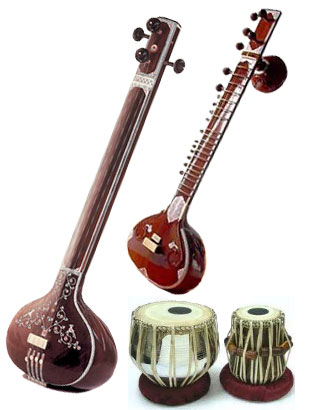
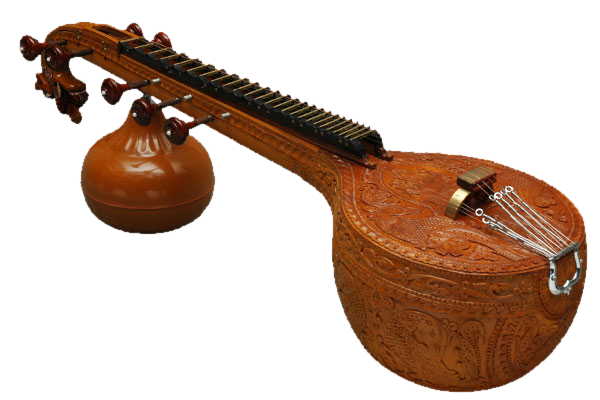 Veena : is a plucked stringed instrument used in Carnatic music. There are several variations of the veena,
which in its South Indian form is a member of the lute family. One who plays the veena is referred to as a
vainika.
Veena : is a plucked stringed instrument used in Carnatic music. There are several variations of the veena,
which in its South Indian form is a member of the lute family. One who plays the veena is referred to as a
vainika.
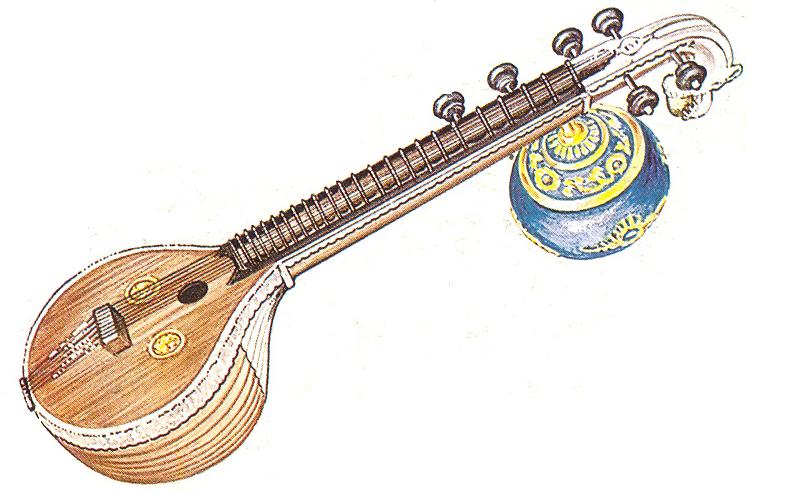 Sitar : The sitar is a plucked stringed instrument predominantly used in Indian classical music.
It derives its resonance from sympathetic strings, a long hollow neck and a gourd resonating chamber.
Sitar : The sitar is a plucked stringed instrument predominantly used in Indian classical music.
It derives its resonance from sympathetic strings, a long hollow neck and a gourd resonating chamber.
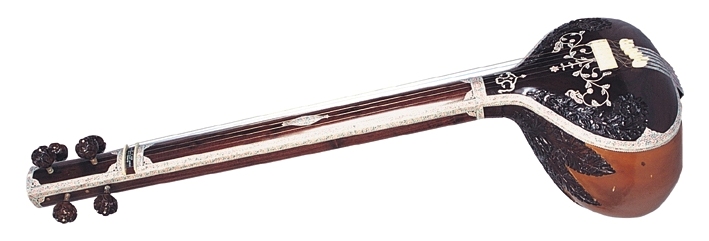 Tanpura or Tambura : The tambura, tanpura, tamboura or taanpura is a long-necked plucked lute (a stringed
instrument found in different forms and in many places).
Tanpura or Tambura : The tambura, tanpura, tamboura or taanpura is a long-necked plucked lute (a stringed
instrument found in different forms and in many places).
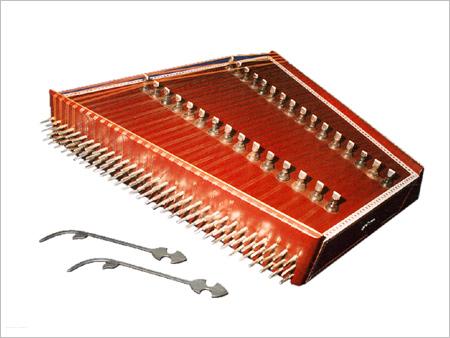 Santoor : Its origin is very old. In ancient sanskrit texts, Santoor has been referred to as Shatatantri vina
(100-stringed vina). In India, the santoor was used as an accompaniment instrument to the folk music of Kashmir.
Santoor is played in a style of music known as the
Sufiana Mausiqi. The Sufi mystics used it as an accompaniment to their hymns.
A typical santoor has two sets of bridges, providing a range of three octaves, which generally has 72 strings.
Santoor : Its origin is very old. In ancient sanskrit texts, Santoor has been referred to as Shatatantri vina
(100-stringed vina). In India, the santoor was used as an accompaniment instrument to the folk music of Kashmir.
Santoor is played in a style of music known as the
Sufiana Mausiqi. The Sufi mystics used it as an accompaniment to their hymns.
A typical santoor has two sets of bridges, providing a range of three octaves, which generally has 72 strings.
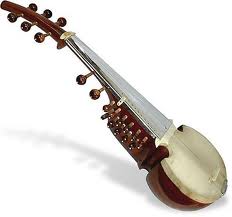 Sarod : The sarod is known for a deep, weighty, introspective sound, in contrast with the sweet, overtone-rich
texture of the sitar, with sympathetic strings that give it a resonant, reverberant quality. It is a fretless instrument
able to produce the continuous slides between notes known as meend (glissandi), which is important to Indian music.
Sarod : The sarod is known for a deep, weighty, introspective sound, in contrast with the sweet, overtone-rich
texture of the sitar, with sympathetic strings that give it a resonant, reverberant quality. It is a fretless instrument
able to produce the continuous slides between notes known as meend (glissandi), which is important to Indian music.
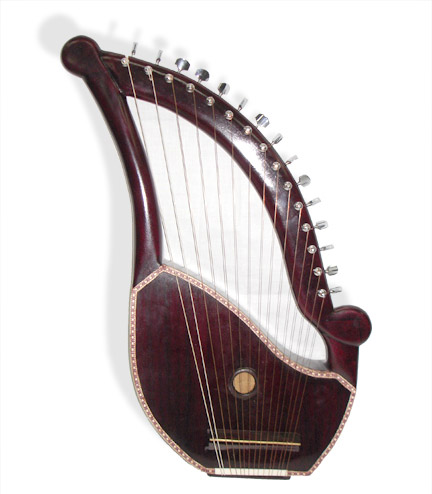 Swar Jhankar : SWAR JHANKAR is a beautiful sounding instrument shaped like a Harp of the western counterpart.It has 15
strings which can be tuned to the scale one wishes to play. The drone can be maintained by plucking the 1st string with one hand
and the desired note with the other. Machine head screws are fitted for easy tuning. C-tuning is the best tuning.
Swar Jhankar : SWAR JHANKAR is a beautiful sounding instrument shaped like a Harp of the western counterpart.It has 15
strings which can be tuned to the scale one wishes to play. The drone can be maintained by plucking the 1st string with one hand
and the desired note with the other. Machine head screws are fitted for easy tuning. C-tuning is the best tuning.
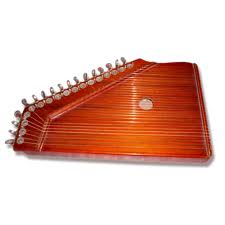 Swar mandal : The swarmandal or
Indian harp is an Indian zither that is
today most commonly used as an accompanying instrument for vocal Hindustani Classical music (the classical music of North India,
Pakistan, and Bangladesh). The name combines swara (notes) and mandal (group), representing its ability to produce a large
number of notes; it is also known popularly as Sur-mandal. Total 30 to 36 strings.
Swar mandal : The swarmandal or
Indian harp is an Indian zither that is
today most commonly used as an accompanying instrument for vocal Hindustani Classical music (the classical music of North India,
Pakistan, and Bangladesh). The name combines swara (notes) and mandal (group), representing its ability to produce a large
number of notes; it is also known popularly as Sur-mandal. Total 30 to 36 strings.
 Surbahar : It is closely related to sitar, but it has a lower tone. Depending on the instrument's size, it is usually pitched
two to five whole steps below the standard sitar, but Indian classical music having no concept of absolute pitch, this may vary.
Professional full-size surbahar with a single gourd and 20 strings- Main-8 and Sympathetic-12 strings.
Surbahar sometimes known as bass sitar.
Surbahar : It is closely related to sitar, but it has a lower tone. Depending on the instrument's size, it is usually pitched
two to five whole steps below the standard sitar, but Indian classical music having no concept of absolute pitch, this may vary.
Professional full-size surbahar with a single gourd and 20 strings- Main-8 and Sympathetic-12 strings.
Surbahar sometimes known as bass sitar.
.jpg) Dilruba : The dilruba is found in the
north, where it is used in religious / spiritual music and light classical songs in the urban areas.
Its name is translated as "robber of the heart." It has a skin head sound box with 4 main strings and 18 sympathetic strings, 20 frets
with special bow and wooden box. There is also well known fact that The Dilruba originates from the Taus and some argue is the work of
the 10th Sikh Guru, Guru Gobind Singh, whilst that of the Taus was the work of Guru Hargobind (the sixth guru of the Sikhs)..
Dilruba : The dilruba is found in the
north, where it is used in religious / spiritual music and light classical songs in the urban areas.
Its name is translated as "robber of the heart." It has a skin head sound box with 4 main strings and 18 sympathetic strings, 20 frets
with special bow and wooden box. There is also well known fact that The Dilruba originates from the Taus and some argue is the work of
the 10th Sikh Guru, Guru Gobind Singh, whilst that of the Taus was the work of Guru Hargobind (the sixth guru of the Sikhs)..
 Esraj : The esraj is found in the east and central areas, particularly Bengal (Bangladesh and Indian states of West Bengal
and Tripura) and it is used in a somewhat wider variety of musical styles than is the dilruba. It�s containing 4 main strings and
15 sympathetic strings and 20 frets. The neck is similar to a sitar in which the frets are tied with thread but it is played with a bow.
Esraj : The esraj is found in the east and central areas, particularly Bengal (Bangladesh and Indian states of West Bengal
and Tripura) and it is used in a somewhat wider variety of musical styles than is the dilruba. It�s containing 4 main strings and
15 sympathetic strings and 20 frets. The neck is similar to a sitar in which the frets are tied with thread but it is played with a bow.
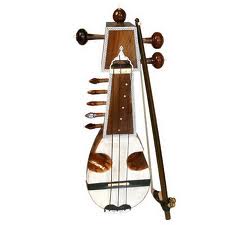 Sarangi : The sarangi is a bowed, short-necked string instrument of north India which originated from ajasthani folk instruments.
It plays an important role in India's Hindustani classical music tradition. Of all Indian musical instruments, it is said to most resemble the
sound of the human voice � able to imitate vocal ornaments such as gamakas (shakes) and meend (sliding movements). Professional sarangi
made from well seasoned tun wood with 39 strings.
Sarangi : The sarangi is a bowed, short-necked string instrument of north India which originated from ajasthani folk instruments.
It plays an important role in India's Hindustani classical music tradition. Of all Indian musical instruments, it is said to most resemble the
sound of the human voice � able to imitate vocal ornaments such as gamakas (shakes) and meend (sliding movements). Professional sarangi
made from well seasoned tun wood with 39 strings.
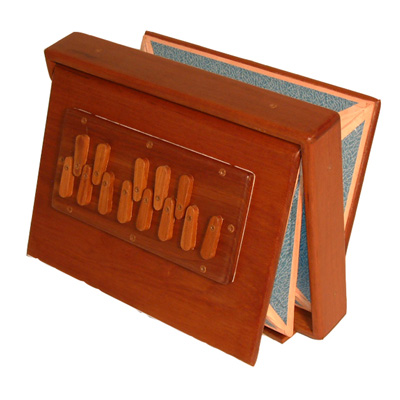 Shruti Box : A shruti box (or sruti box) is a small wooden instrument that traditionally works on a system of bellows. It is
similar to a harmonium and is used to provide a dronein a practice session or concert of Indian classical music.
Shruti Box : A shruti box (or sruti box) is a small wooden instrument that traditionally works on a system of bellows. It is
similar to a harmonium and is used to provide a dronein a practice session or concert of Indian classical music.
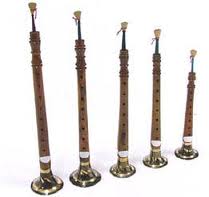 Shennai or Mangal Vadya : is an aerophonic (wind) instrument, a double reed conical oboe, common in North India, West
India and Pakistan, made out of wood, with a metal flare bell at the end. The South Indian equivalent of the shehnai is the nadaswaram.
Shennai or Mangal Vadya : is an aerophonic (wind) instrument, a double reed conical oboe, common in North India, West
India and Pakistan, made out of wood, with a metal flare bell at the end. The South Indian equivalent of the shehnai is the nadaswaram.
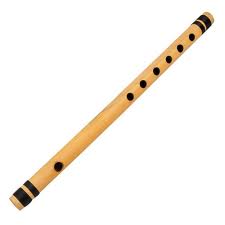 Flute or Bansuri : The bansuri is a transverse flute of India made from a single hollow shaft of bamboo with six or seven finger holes. A flute produces sound when a stream of air directed across a hole in the instrument creates a vibration of air at the hole. The flute player changes the pitch of the sound produced by opening and closing holes in the body of the instrument, thus changing the effective length of the resonator and its corresponding resonant frequency. By varying the air pressure, a flute player can also change the pitch of a note by causing the air in the flute to resonate at a harmonic other than the fundamental frequency without opening or closing any holes. The Bansuri is revered as Lord Krishna's divine musical instrument, and is often associated with Krishna's Rasa lila; mythological accounts tell of the tunes of Krishna's flute having a spellbinding and enthralling effect not only on the women of the Braj, but even on the animals and birds of the region.
Flute or Bansuri : The bansuri is a transverse flute of India made from a single hollow shaft of bamboo with six or seven finger holes. A flute produces sound when a stream of air directed across a hole in the instrument creates a vibration of air at the hole. The flute player changes the pitch of the sound produced by opening and closing holes in the body of the instrument, thus changing the effective length of the resonator and its corresponding resonant frequency. By varying the air pressure, a flute player can also change the pitch of a note by causing the air in the flute to resonate at a harmonic other than the fundamental frequency without opening or closing any holes. The Bansuri is revered as Lord Krishna's divine musical instrument, and is often associated with Krishna's Rasa lila; mythological accounts tell of the tunes of Krishna's flute having a spellbinding and enthralling effect not only on the women of the Braj, but even on the animals and birds of the region.
 Admissions Apply online
Admissions Apply online 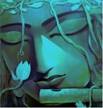 APPLY FOR
APPLY FOR



 Tabla : The term 'tabla is derived from an Arabic word, tabl, which simply means "drum." It�s a very popular Indian
percussion instrument (of the membranophone family, similar to bongos), used in Hindustani classical music and in popular and
devotional music of the Indian subcontinent.
Tabla : The term 'tabla is derived from an Arabic word, tabl, which simply means "drum." It�s a very popular Indian
percussion instrument (of the membranophone family, similar to bongos), used in Hindustani classical music and in popular and
devotional music of the Indian subcontinent.
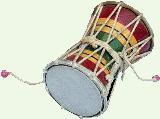 Damru : A damaru or damru is a small two-headed drum, used in Hinduism and Tibetan Buddhism, In the Hindu mythology it�s
known as a power drum, and when played, it is believed to generate spiritual energy. It is associated with the Hindu deity Shiva.
Damru : A damaru or damru is a small two-headed drum, used in Hinduism and Tibetan Buddhism, In the Hindu mythology it�s
known as a power drum, and when played, it is believed to generate spiritual energy. It is associated with the Hindu deity Shiva.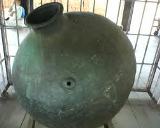 Mizhavu : A mizhav or mizhavu is a big copper drum played as an accompanying percussion instrument in the Koodiyattam and Koothu,
performing arts of Kerala . It is played by the Ambalavasi Nambiar community.
Mizhavu : A mizhav or mizhavu is a big copper drum played as an accompanying percussion instrument in the Koodiyattam and Koothu,
performing arts of Kerala . It is played by the Ambalavasi Nambiar community.
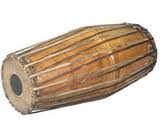 Mridangam : It is the primary rhythmic accompaniment in a Carnatic music ensemble. The mridangam is also played in Carnatic
concerts in countries outside of India, including Sri Lanka, Singapore, Malaysia, Australia, United Kingdom, Canada, and the
United States. During a percussion ensemble, the mridangam is often accompanied by the ghatam, kanjira, and the morsing.
Mridangam : It is the primary rhythmic accompaniment in a Carnatic music ensemble. The mridangam is also played in Carnatic
concerts in countries outside of India, including Sri Lanka, Singapore, Malaysia, Australia, United Kingdom, Canada, and the
United States. During a percussion ensemble, the mridangam is often accompanied by the ghatam, kanjira, and the morsing.
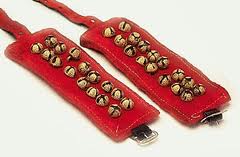 Ghungroo : A Ghungroo, also known as Ghunghroo or Ghungur (Bengali) or Salangai (Tamil) is one of many small metallic
bells strung together to form Ghungroos, a musical anklet tied to the feet of classical Indian dancers. Ghungroos or Salangais
are worn in traditional performances of the classical Indian dance forms: Bharatnatyam, Kathak, Kuchipudi, and Odissi etc.
Ghungroo : A Ghungroo, also known as Ghunghroo or Ghungur (Bengali) or Salangai (Tamil) is one of many small metallic
bells strung together to form Ghungroos, a musical anklet tied to the feet of classical Indian dancers. Ghungroos or Salangais
are worn in traditional performances of the classical Indian dance forms: Bharatnatyam, Kathak, Kuchipudi, and Odissi etc.
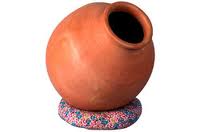 Ghatam : the ghatam (Sanskrit: ghatam "pot", Tamil: katam, Kannada: ghata, Telugu: ghatat) is a percussion instrument used
in the Carnatic music of South India. Its analogue in Rajasthan is known as the madga and pani mataqa "water jug". The ghatam usually
accompanies a mridangam.
Ghatam : the ghatam (Sanskrit: ghatam "pot", Tamil: katam, Kannada: ghata, Telugu: ghatat) is a percussion instrument used
in the Carnatic music of South India. Its analogue in Rajasthan is known as the madga and pani mataqa "water jug". The ghatam usually
accompanies a mridangam.
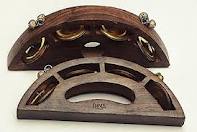 Khartal : is found three kind of in society.
Khartal : is found three kind of in society.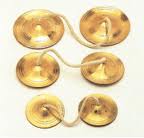 Manjeera : is a traditional musical instrument in India. It is also known as manjeera, taal, jalra, khart�l or kart�l.
It is used in various religious ceremonies of India, especially with bhajans in temples. Manjira are usually made of bronze,
brass, copper zinc or Bell metal and connected with a copper cord which passes through holes in their center.
Manjeera : is a traditional musical instrument in India. It is also known as manjeera, taal, jalra, khart�l or kart�l.
It is used in various religious ceremonies of India, especially with bhajans in temples. Manjira are usually made of bronze,
brass, copper zinc or Bell metal and connected with a copper cord which passes through holes in their center.
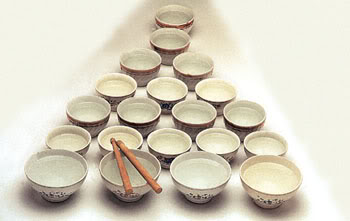 Jal tarang : It consists of a set of ceramic or metal bowls tuned with water. The bowls are played by striking the edge with beaters,
one in each hand. In other words jal tarang means "waves in water" but indicates motion of sound created or modified with the aid of water.
Jal tarang : It consists of a set of ceramic or metal bowls tuned with water. The bowls are played by striking the edge with beaters,
one in each hand. In other words jal tarang means "waves in water" but indicates motion of sound created or modified with the aid of water.
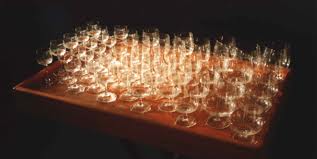 Kanch tarang or Glass Harp : It's not an Indian
classical instrument but it's like Jal - Tarang.
Kanch tarang or Glass Harp : It's not an Indian
classical instrument but it's like Jal - Tarang.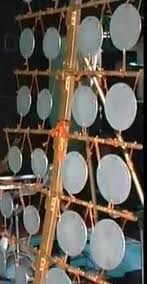 Loh tarang : It consists of a set of iron circular plates, of different sizes, held in a frame. Each plate is pitched to a
musical note and they are struck with sticks on each hand. 'Tarang' means waves. Plates sound depends on the different size of plate and
hand movement. Theory is based like Jal-Tarang.
Loh tarang : It consists of a set of iron circular plates, of different sizes, held in a frame. Each plate is pitched to a
musical note and they are struck with sticks on each hand. 'Tarang' means waves. Plates sound depends on the different size of plate and
hand movement. Theory is based like Jal-Tarang. 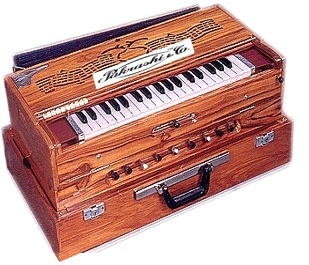 Harmonium or Hand pumped : It's a free-standing keyboard instrument similar to a reed organ. Sound is produced by air being blown
through sets of free reeds, resulting in a sound similar to that of an accordion. The air is usually supplied by bellows operated by the
foot, hand, or knees.
Harmonium or Hand pumped : It's a free-standing keyboard instrument similar to a reed organ. Sound is produced by air being blown
through sets of free reeds, resulting in a sound similar to that of an accordion. The air is usually supplied by bellows operated by the
foot, hand, or knees.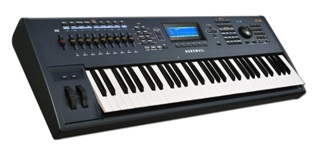 Synthesizer or Keyboard : A sound synthesizer (often abbreviated as "synthesizer" or "synth") is an electronic instrument capable
of producing a wide range of sounds. Synthesizers use a number of different technologies or programmed algorithms to generate signal,
each with their own strengths and weaknesses. Among the most popular waveform synthesis techniques are subtractive synthesis, additive
synthesis, wavetable synthesis, frequency modulation synthesis, phase distortion synthesis, physical modeling synthesis and sample-based
synthesis.
Synthesizer or Keyboard : A sound synthesizer (often abbreviated as "synthesizer" or "synth") is an electronic instrument capable
of producing a wide range of sounds. Synthesizers use a number of different technologies or programmed algorithms to generate signal,
each with their own strengths and weaknesses. Among the most popular waveform synthesis techniques are subtractive synthesis, additive
synthesis, wavetable synthesis, frequency modulation synthesis, phase distortion synthesis, physical modeling synthesis and sample-based
synthesis.
 Guitar is a plucked string instrument played with fingers or a pick. The guitar consists of a body with a rigid neck, to which the strings, generally six in number, are attached. Guitars are traditionally constructed of various woods and strung with animal gut or, more recently, with either nylon or steel strings. There are two primary families of guitars: acoustic and electric. Acoustic guitars (and similar instruments) with hollow bodies have been in use for over a thousand years. There are three main types of modern acoustic guitar: the classical guitar, the steel-string acoustic guitar, and the archtop guitar. The classical guitar is often played as a solo instrument using a comprehensive finger picking technique. Electric guitars rely on an amplifier that can electronically manipulate tone. Electric guitars have had a continuing profound influence on popular culture. Guitars are recognized as a primary instrument in genres such as blues, bluegrass, country, flamenco, jazz, jota, mariachi, metal, reggae, rock, soul, and many forms of pop.
Guitar is a plucked string instrument played with fingers or a pick. The guitar consists of a body with a rigid neck, to which the strings, generally six in number, are attached. Guitars are traditionally constructed of various woods and strung with animal gut or, more recently, with either nylon or steel strings. There are two primary families of guitars: acoustic and electric. Acoustic guitars (and similar instruments) with hollow bodies have been in use for over a thousand years. There are three main types of modern acoustic guitar: the classical guitar, the steel-string acoustic guitar, and the archtop guitar. The classical guitar is often played as a solo instrument using a comprehensive finger picking technique. Electric guitars rely on an amplifier that can electronically manipulate tone. Electric guitars have had a continuing profound influence on popular culture. Guitars are recognized as a primary instrument in genres such as blues, bluegrass, country, flamenco, jazz, jota, mariachi, metal, reggae, rock, soul, and many forms of pop.
 violin is a string instrument, usually with four strings tuned in perfect fifths. It is the smallest, highest-pitched member of the violin family of string instruments, which also includes the viola, cello, and double bass. The violin is sometimes informally called a fiddle, regardless of the type of music played on it, The parts of a violin are usually made from different types of wood and it is usually strung with gut, nylon or other synthetic, or steel strings. The violinist produces sound by drawing a bow across one or more strings (which may be stopped by the fingers of the other hand to produce a full range of pitches), by plucking the strings (with either hand), or by a variety of other techniques. The violin is played by musicians in a wide variety of musical genres, including Baroque music, classical, jazz, folk music, rock and roll, and Soft rock. The violin has come to be played in many non-Western music cultures all over the world.
violin is a string instrument, usually with four strings tuned in perfect fifths. It is the smallest, highest-pitched member of the violin family of string instruments, which also includes the viola, cello, and double bass. The violin is sometimes informally called a fiddle, regardless of the type of music played on it, The parts of a violin are usually made from different types of wood and it is usually strung with gut, nylon or other synthetic, or steel strings. The violinist produces sound by drawing a bow across one or more strings (which may be stopped by the fingers of the other hand to produce a full range of pitches), by plucking the strings (with either hand), or by a variety of other techniques. The violin is played by musicians in a wide variety of musical genres, including Baroque music, classical, jazz, folk music, rock and roll, and Soft rock. The violin has come to be played in many non-Western music cultures all over the world.
 Conga, or more properly the tumbadora, is a tall, narrow, single-headed Cuban drum, used both in Afro-Caribbean religious music and as the principal instrument in rumba. Congas are now very common in Latin music, including salsa music, merengue music, and Reggae, as well as many other forms of American popular music. Most modern congas have a staved wooden or fiberglass shell, and a screw-tensioned drumhead. They are usually played in sets of two to four with the fingers and palms of the hand. Conga drums are tunable to different notes, have many kind of rhythms and have five basic strokes - Open tone, Bass tone, Slap tone, Touch tone and Muffled or Mute tone. Bongos are an Afro-Cuban percussion instrument producing relatively high-pitched sounds compared to conga drums. The drums are of different size: the larger drum is called in Spanish the hembra (female) and the smaller the macho (male). They are membranophones, or instruments that create sound by a vibration against a stretched membrane.
Conga, or more properly the tumbadora, is a tall, narrow, single-headed Cuban drum, used both in Afro-Caribbean religious music and as the principal instrument in rumba. Congas are now very common in Latin music, including salsa music, merengue music, and Reggae, as well as many other forms of American popular music. Most modern congas have a staved wooden or fiberglass shell, and a screw-tensioned drumhead. They are usually played in sets of two to four with the fingers and palms of the hand. Conga drums are tunable to different notes, have many kind of rhythms and have five basic strokes - Open tone, Bass tone, Slap tone, Touch tone and Muffled or Mute tone. Bongos are an Afro-Cuban percussion instrument producing relatively high-pitched sounds compared to conga drums. The drums are of different size: the larger drum is called in Spanish the hembra (female) and the smaller the macho (male). They are membranophones, or instruments that create sound by a vibration against a stretched membrane.
 A musical keyboard is the set of adjacent depressible levers or keys on a musical instrument, particularly the piano. Keyboards typically contain keys for playing the twelve notes of the Western musical scale, with a combination of larger, longer keys and smaller, shorter keys that repeats at the interval of an octave. Depressing a key on the keyboard causes the instrument to produce sounds, either by mechanically striking a string or tine (piano, electric piano, clavichord); plucking a string (harpsichord); causing air to flow through a pipe (organ); or strike a bell (carillon). On electric and electronic keyboards, depressing a key connects a circuit (Hammond organ, digital piano and synthesizer). Since the most commonly encountered keyboard instrument is the piano, the keyboard layout is often referred to as the "piano keyboard".
A musical keyboard is the set of adjacent depressible levers or keys on a musical instrument, particularly the piano. Keyboards typically contain keys for playing the twelve notes of the Western musical scale, with a combination of larger, longer keys and smaller, shorter keys that repeats at the interval of an octave. Depressing a key on the keyboard causes the instrument to produce sounds, either by mechanically striking a string or tine (piano, electric piano, clavichord); plucking a string (harpsichord); causing air to flow through a pipe (organ); or strike a bell (carillon). On electric and electronic keyboards, depressing a key connects a circuit (Hammond organ, digital piano and synthesizer). Since the most commonly encountered keyboard instrument is the piano, the keyboard layout is often referred to as the "piano keyboard".
 Drum is a member of the percussion group of musical instruments, which is technically classified as the membranophones. All types of drums such as timpani for example are always tuned to a certain pitch. Drums are usually played by the hand, or by one or two sticks. In many traditional cultures drums have a symbolic function and are often used in religious ceremonies. Drums are often used in music therapy, especially the hand drums. There are many different types of drums played all over the world. Each type of drum head serves its own musical purpose and has its own unique sound.
Drum is a member of the percussion group of musical instruments, which is technically classified as the membranophones. All types of drums such as timpani for example are always tuned to a certain pitch. Drums are usually played by the hand, or by one or two sticks. In many traditional cultures drums have a symbolic function and are often used in religious ceremonies. Drums are often used in music therapy, especially the hand drums. There are many different types of drums played all over the world. Each type of drum head serves its own musical purpose and has its own unique sound.
 The piano is a keyboard musical instrument and is widely used in classical and jazz music for solo performances, ensemble use, chamber music and accompaniment; the piano is also very popular as an aid to composing and rehearsal. Modern pianos have two basic configurations (with subcategories): the grand piano and the upright piano. The piano is a crucial instrument in Western classical music, jazz and most other complex western musical genres. A large number of composers are proficient pianists because the piano keyboard offers an easy means of complex melodic and harmonic interplay.
The piano is a keyboard musical instrument and is widely used in classical and jazz music for solo performances, ensemble use, chamber music and accompaniment; the piano is also very popular as an aid to composing and rehearsal. Modern pianos have two basic configurations (with subcategories): the grand piano and the upright piano. The piano is a crucial instrument in Western classical music, jazz and most other complex western musical genres. A large number of composers are proficient pianists because the piano keyboard offers an easy means of complex melodic and harmonic interplay.


Stay Up to Date With Whats Happening